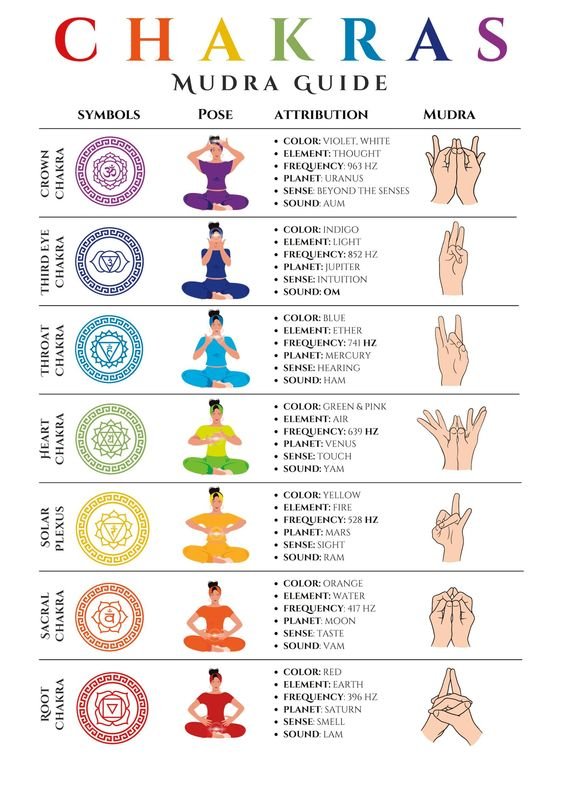By: Kirti Mishra

Chakras are believed to be energy centres in the human body, originating from ancient Indian spiritual traditions, specifically within the practice of yoga and Ayurveda.
The concept of chakras appears in texts such as the Vedas, Upanishads, and later in Tantric Buddhism and Hinduism.
Chakras are believed to be spinning wheels of energy that correspond to different physical, emotional, and spiritual aspects of our being.
Similar to the seven notes of music and the seven colours in a spectrum, the human body is also composed of seven energies centres, called chakras. Let’s have a look at each one more closely.
1. Muladhara Chakra (Root Chakra) – The foremost chakra Muladhara is located at the base of the spine, an area between the genital organ, and the anal outlet, also known by the name perenium. Its associated colour is red.
The word Muladhara, is a combination of two sanskrit words ‘mula’ means ‘source’ and adhara means ‘support’.
Muldhara is also regarded as the most rigid chakra, and is
associated with the earth elements. Even physiologically, this is the place where the grossest elements of the body reside.
2. Swadhishthana Chakra (Sacral Chakra) – This second chakra Swadhishthana is located at the top of genital organ. The word Swadishthana means well-established. Its associated colour is orange.
This chakra deals with the faculties of pleasure and sexuality, and is represented by the water element, which correlates with the physiological presence of the exact same element in the human body.
3. Manipura Chakra ( Navel Chakra) – The next in the sequence is Manipura chakra, which is located just below the navel.
This is also the level at which we were connected to our mothers and received nourishment inside the womb. Its associated colour is yellow.
This chakra is faculties of power, hunger and nourishment. It is represented by the fire element.
4. Anahata Chakra (Heart Chakra or Solar Plexus) – The fourth chakra Anahata is located just below the part of the body where our rib cage meets. Its associated colour is green.
The word ‘Anahata’ refers to unstuck sound and it deals with kindness, love and compassion. It is represented by the air element.
5. Vishuddhi Chakra (Throat Chakra) – This fifth chakra Vishuddhi is located at the pit of the throat. The word Visudhhi is defined as a purifier or a filter. Its associated colour is blue.
This chakra deals with speech and communication. It is represented by the sky element.
6. Ajna Chakra (Third eye chakra) –Ajna, the second last chakra is located between the eyebrows. The word refers to ‘command’. This chakra deals with sight and perception. Its associated colour is indigo.
Ajna chakra is the centre of intuition, insight, and spiritual awareness. It enhances inner vision and wisdom.
Once Ajna Chakra is fully activated, it is believed that the third eye also gets opened, which is a representation of perception beyond the dualities of existence and will make one dispassionate towards everything.
This is represented by Shiva by burning everything within his sight, if he opens his third eye. The associated colour is indigo.
7:- Sahasrara Chakra (Crown Chakra) – The seventh and the last chakra is located at the top of the head. The word ‘Sahasrara’ means a thousand petals of lotus. This should not be understood literally as a thousand petals but rather as “thousands of petals” means innumerable. The colour associated with it is violet.
This chakra symbolizes our connection to the divine and higher consciousness. It is linked to enlightenment and spiritual transcendence.
Yogis who are in deep states of samadhi have their energies at this centre.
This is a states when even the sense of self is absent during meditation
Balancing these chakras is believed to be crucial for overall well-being. An imbalance or blockage in any chakra can manifest as physical ailments, emotional disturbances, or spiritual disconnection.
Practices like meditation, yoga, Reiki, and other forms of energy healing aim to balance the chakras, facilitating the free flow of energy throughout the body. By harmonizing the chakras, individuals can achieve improved health, emotional stability, and spiritual growth, leading to a more balanced and fulfilling life.

























